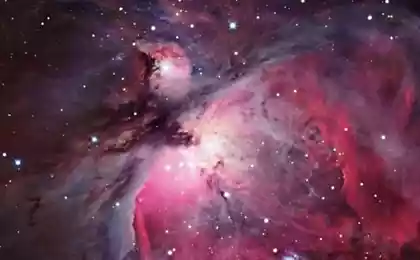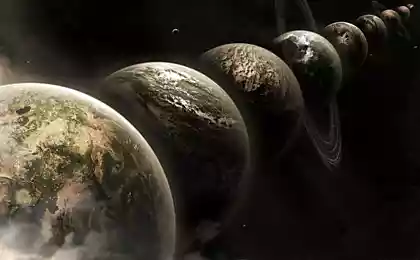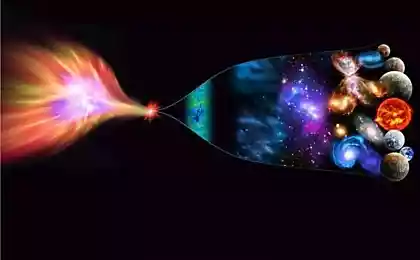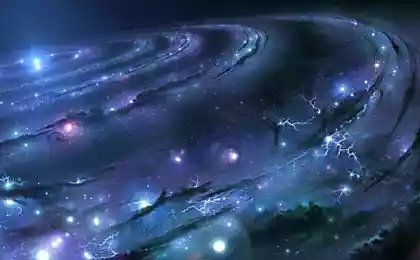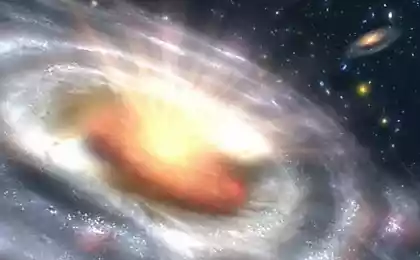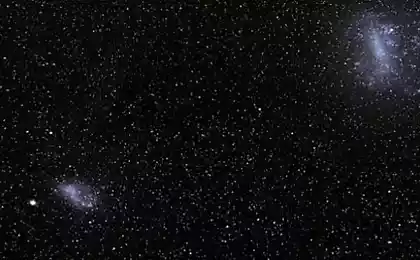507
10 Unexpected and Curious Space Discoveries

Almost infinite space never ceases to amaze us, ordinary people, with its beautiful lights and hypnotic patterns. However, even scientists and astronomers are often surprised by some discoveries.
Massive debris ring
The newly discovered star, IRAS 13481-6124, has already contributed to understanding how giant stars are made. There are different classifications of stars, but they tend to boil down to "small" and "big." And our sun is among the small ones. It is among a small subset of stars and doesn’t even have enough mass to die in a glorious explosion like most stars in the universe. Our Sun will just die with a weak cough, not a glorious cry. Some theories suggest that larger stars can form when smaller ones join together, but the IRAS formation process discredits this idea of stellar mergers.
And although IRAS is still a newborn baby, it is already quite healthy and has gained fat. The star is 10,000 light-years from Earth in the constellation Centaurus and is surrounded by a disk of stellar debris — stars in their infancy. This is the first time astronomers have seen such an event. In addition, a metal-rich, heavy star, 20 times heavier than the Sun, like IRAS, contains the elements needed to form planets — perhaps even life.
Grand void
Looking into space is like looking through a kaleidoscope: polychromatic nebulae and bright galaxies look extremely spectacular. And one of the things we know about space is that it's full of stuff. Yet the universe throws us incredible chunks of “nothing”—like the Bootes Void, which is simply grand in its emptiness.
Named for its proximity to the constellation Bootes, this void is also known as the Great Void. It was discovered in 1981 by Robert Kirchner and his colleagues, who were shocked to discover what appeared to be a ball of emptiness in space. After careful analysis, Kirchner and his team were able to detect only 60 minuscule galaxies in this region spanning a whopping 250-300 million light years.
By all laws, there must be at least 10,000 galaxies in this place. For comparison, the Milky Way has 24 neighbors within 3 million years, meaning that they can be reached almost on foot in space boots.
Technically, this void should not exist, since current theories only allow for much smaller “empty” spaces. The sheer scale of this void monster requires new theories, including the most interesting ones, up to and including alien intervention.
Ancient collision with dark matter
There is a problem with our galaxy. It rings like a bell, and astronomers don’t know why. According to one recent theory, this anomaly is the result of a massive disturbance that occurred 100 years ago. This disturbance came in the form of a collision—something with something, a small galaxy, or rushing dark matter.
If this theory is supported, it will solve the galactic mystery. And this one. The northern and southern hemispheres of our galaxy are not the same, the structure changes distinctly as we pass through the center of the Milky Way. This imbalance is supposed to be caused by vertical waves, which are the result of invisible “dark matter satellites” (like invisible galaxies) that have passed through the galactic plane. Computer simulations have shown that this discord will settle down pretty soon, perhaps as early as 100 million years from now.
The smallest and oldest galaxies
The history of our universe is hidden from us not only by unimaginable intervals of time and distance, but also by a seemingly infinite amount of matter. Gas and dust distort the rays of light that serve as our only evidence of the early universe. But sometimes its immensity plays in our favor, and astronomers can effectively observe those regions of space that lie behind massive objects, as we see that photons are distorted and magnified. This is a natural consequence of gravitational lensing, which allows scientists to observe faint, small and old galaxies.
Using the galaxy cluster Abell 2744, astronomers recently discovered thousands of galaxies that are 12 billion years old, almost as old as the universe itself. Although Abell 2744 is only 3.5 billion light-years away, the magnifying effect is so great that it has provided us with the deepest picture of the universe at all: the first boundary shield. Because the lens increases the apparent size of distant objects by up to 20 times, we are able to observe tiny and faint objects that are almost at the very end of the observable cosmos.
Giant flow of hydrogen
A giant stream of pure hydrogen has been detected in NGC 7448. Scientists are scratching their heads. Located 500 million light-years away, the hydrogen bridge stretches 2.6 million light-years long (almost 20 times the size of the Milky Way) and connects several galaxies to its ghostly green appendages.
Astronomers never expected to find such a gas monster, and what a surprise it was when it became known that such large collections of hydrogen had never been found outside galaxies. Second, the size of this thing is simply staggering: it has more hydrogen than the Milky Way and Andromeda galaxies combined. There are several possible explanations, the most interesting of which implies that we see remnants of a galactic collision. The gravitational influence of the participating galaxies pulled out and stretched the stream of gas like a giant vermicella.
A planet that should not have been
Kepler 78b is an anomaly: it shouldn't exist. Like Jupiter’s moon Io, Kepler 78b is a hellish planet of lava and fire. However, its strange size, combined with its unusually close orbit around stars, has caused little buzz in the scientific community.
Astronomers do not know how a planet of this size got so close to its parent star, as there are no theories of planet formation that could explain this. And when we say "close," we mean the range of wobble -- Kepler 78b is just 1.6 million kilometers from the sun and completes the year in just 9 hours.
The planet is only 1.2 times the size of Earth and almost twice as massive, so it is very similar to our planet. Its location provides thorough roasting, and the temperature on the surface reaches 2400 degrees Celsius. The data also show that the star was much larger in its youth, so the planet now feels even more comfortable. Since the planet obviously could not have formed where it is now, new theories about how it got there should emerge. 78b is likely to be destroyed by its star as it spirals toward its doom.
Massive star cluster in the Milky Way
Just 25,000 light-years away is the Quintuplet Cluster, one of the most impressive sights of the Milky Way. The cluster is a kind of cosmic kindergarten full of young and bright stars. This area of space is also very dense, the stars are located almost slender rows.
And with such short distances between them, they form a hot gaseous cocktail that reaches temperatures of 50 million degrees Celsius. The cluster is also extremely close to the center of the galaxy, home to the supergiant black hole Sagittarius A, which absorbs matter with alarming gluttony.
Despite being the most massive, dense and bright cluster in our galaxy, the Quintuplet Cluster is virtually invisible due to the sheer amount of debris in front of it. The center of the Milky Way is closed by clusters of white hot gas and dust. Therefore, Quintuplet remained hidden from astronomers until 1990, when they were able to see it with infrared light.
Again, Quintuplet will be available to us for a limited time. Because it is only a short walk from the center of the galaxy, it will soon be ripped apart by gravity. On the other hand, for the next million years you can enjoy it.
Giant exosolar system
As our stellar encyclopedia grows, we find that many stars have multiple planetary systems. There are 466 such examples, although almost half of them have only two planets. Young systems are easier to detect because they retain residual heat left over from formation, and one such example is HR 8799. A large young star has sheltered four gas giants, next to which Jupiter will be just a toy. Fortunately, the distance from the planets to the star ensures that their light signature, visible in infrared, is very bright and the star’s light does not interfere with it.
And while the youngest member of this alien solar system causes Jupiter to blush, the largest is 35 times larger than Jupiter. Its size, age and the fact that the system is only 130 light-years from Earth make it easy to detect HR 8799. And the fact that we see such gas giants at such a distance from the solar center opens the way for new theories about how planets form.
The Milky Way Blanket
Our Milky Way is embroiled in a massive cosmic mystery: it lacks baryons. Some of the expected subatomic particles simply disappeared. In principle, it is unlikely that there are many more things in the galaxy that have yet to be found, let alone dark matter, so the question of the loss of baryons remains open.
However, a recent discovery could finally put an end to this puzzle, as our galaxy seems to be shrouded in a huge cloud of hot gas. It forms a kind of halo around the Milky Way and burns at a temperature of 1-2.5 million degrees Celsius. The Chandra Observatory, in collaboration with the European XMM Newton and the Japanese satellite Suzaku, has been able to observe some strange things happening in the vicinity of our solar system. It turned out that the galaxy is crowned by an incredibly large cloud of supersaturated boiling gas.
This halo of gas of uncertain size can be several times the size of the galaxy itself, or even more.
The largest radio galaxy
Radio galaxies are incredibly enjoyable to watch. They are called so because they emit a large amount of energy in the radio wavelength. The jets that hit the centers of galaxies are accelerated by massive black holes, and this activity makes them a prime target for our radio telescopes.
The largest of the radio galaxies is called J1420-0545 and extends for 15 million light years in space. It is about 4.5 megaparsecs across. Radio galaxies live fast and die young, splashing jets for only 10,000 years or so - not even 1% of the average lifespan of galaxies will gain.
Because these galaxies emit such crazy amounts of matter and radiation, they exhaust themselves very quickly. A moment later (on a cosmological scale) they simply disappear and become inconspicuous relics.
Source: hi-news.ru
Source: /users/1617
About wolves, the fragility of ecosytem and ecology of fear
Ortoreksiya — how dangerous an unhealthy passion for healthy eating






